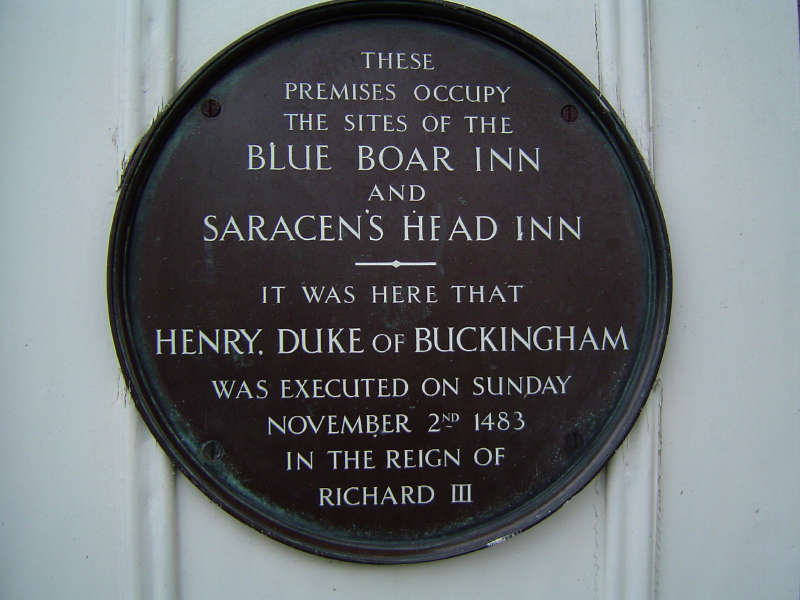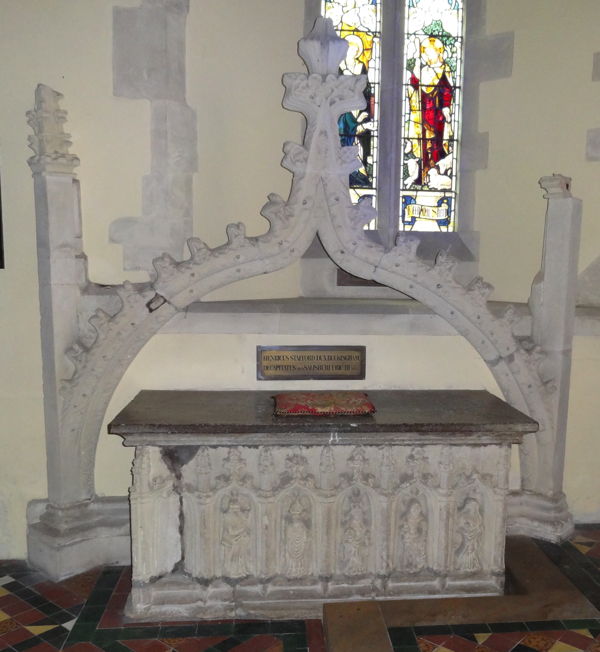Plaque number 31 can be found at this location.
Blue Boar Row overlooks the Market and Guildhall squares, the scene of many episodes in the city’s history. Towards the western end of the Row is a 19th century Italianate façade built of golden hamstone originally occupied by the Wilts and Dorset Bank. At the eastern end is a 13th century building (Nuggs) which won its restorer a Civic Society award. Halfway between these buildings is Debenhams whose frontage carries three almost identical plaques commemorating the execution of a duke.
The O/S grid position is SU 14447 East 30067 North.
These premises occupy the sites of the Blue Boar Inn and Saracen's Head Inn.
It was here that Henry, Duke of Buckingham was executed on Sunday November 2nd 1483 in the reign of Richard III.


Henry Stafford, second Duke of Buckingham, was born in 1453 during a time of dynastic turbulence (the Wars of the Roses). By 1483 he had become a power in the land. In part this was due to his lineage and family connections. He was a direct descendent of Edward III’s youngest son Thomas of Woodstock. His mother was a member of the powerful Beaufort family. After his father had died of wounds received in battle, Henry was made a ward of the Queen, Elizabeth Woodville. He married the queen’s sister. He was wealthy, with large estates in the Welsh borders. The main reason for his rise, however, was that he backed Richard of Gloucester’s bid for the throne. His support was a major factor in the appointment of Richard as protector of the young king Edward V. His reward was to be made justiciar and chamberlain of North and South Wales and constable of the Welsh royal castles. In June 1483 he spoke at the London Guildhall, urging the citizens to accept Richard as king. It was largely thanks to Buckingham that Richard was able to depose Edward and take the throne as Richard III. Buckingham served as chamberlain at Richard’s coronation and soon after was made Lord High Constable of England, in those days one of the great offices of state.
How surprising then that only 6 weeks after Richard’s success, Buckingham was persuaded to join a conspiracy against him. The conspiracy was led by John Morton, bishop of Ely, and included the Bishop of Exeter and members of the Beaufort and Woodville families. The original aim was to depose Richard and reinstate Edward V. When it emerged that Edward was probably dead, the conspirators decided to back the claim of the Earl of Richmond (the future Henry VII) who was in exile in Brittany. Sources suggest that Buckingham’s motives were disappointment at Richard’s failure to keep a promise to grant him lands and a sense that he was undervalued. Such sudden changes in allegiance were however common amid the intrigue, treachery, betrayal and internecine bloodletting characteristic of the times.
Buckingham’s part in the plot was to raise an army from his Welsh estates and to bring it south. He would then join the other conspirators and meet the Earl of Richmond at Poole. King Richard got to hear of the plans and set off to meet the threat. Buckingham’s army found the River Severn impassable because of floods. In spite of being (by virtue of his title) the king’s general, Buckingham had limited military experience and could not stop his army melting away. Deserted by all, he had to hide in the house of one of his tenants in the Shrewsbury area. However this tenant, perhaps following the example set by his lord, betrayed him. He was handed over to the Sheriff of Shropshire who sent him under guard to Salisbury where the king and his army were encamped. Buckingham arrived on 1st November and asked to see the king. This request was refused. The next day, All Souls Day 1483, Buckingham was beheaded in the Market Square. Within Salisbury there had been some support for the uprising. William Halle, son of the mayor John Halle, was arrested for his part in it. Unlike his leader, he escaped with his life (see plaque 13). Another participant was John Cheney, the bishop’s bailiff.
You had to be of a certain social standing to be executed in the Market Square. One man who clearly met this criterion was Lord Charles Stourton of Kilmington in Somerset who in February 1556 was condemned to death for murdering his neighbours, William and John Hartgill, in the course of a feud. On 6 March 1556 Stourton was hanged in the market place having (according to the Newgate Calendar) ‘made great lamentation for his wilful and impious deeds.’ Significantly in this context, the Calendar adds that four of Stourton’s servants who were condemned with him as his accomplices were hanged (no doubt just as efficiently but in front of fewer spectators) ‘in the country near the place where the murder was committed.’ Had they been from Salisbury they would have probably been taken to Fisherton Field, near the present Emmanuel Church, where three Protestant martyrs were executed later that month (see plaque 3). After 1610, non-celebrity hangings usually took place at Fisherton Gaol; see plaque 15.
No one knows for certain where Buckingham is buried. One contemporary source says that he was interred at the Franciscan friary which was located near the junction of Brown Street and St Ann Street (see plaque 79). However St Peter’s church at Britford houses a tomb which purports to be Buckingham’s. It comprises an arch and tomb chest. The problem, according to notes in the church, is that the arch is in a style earlier than that of the chest. It is possible that Buckingham’s remains were at some time after 1483 exhumed from the friary, placed in the chest brought to Britford and placed within an existing arch, but there is no record of this. Haskins records that during the 19th century it was commonly believed that the remains were moved when Henry VIII dissolved the monasteries. A 19th century plate on the tomb identifies it as Buckingham’s.

Another candidate is the Blue Boar/Saracen’s Head site. The 1843 Salisbury volume of the History of Modern Wiltshire says ’a most remarkable circumstance connected with this location is the recent discovery of a skeleton, found just under the pavement, while making alterations to an outhouse of the Saracen’s Head’. The skeleton lacked a head and right arm. The lack of a head suggested that it might be Buckingham but the missing arm could not be explained. For some unrecorded reason the skeleton was broken up inmediately and so there was no further investigation. As might be expected, Buckingham is reputed to haunt the site which is now often included in ghost tours of the city.
Between the 15th and 19th centuries these two inns occupied what is now the Debenham’s site. In 1404 Thomas Burford granted his daughter Joanne and her husband William Toyl ‘all the tenement that I hold between Chipper Lane and the Market Place’ probably including the Boar site. By 1444 William Ludlow had acquired the site. In that year he placed a contract with John Fayrebowe, carpenter, for the building of a 2 storey hall ‘within the Boar against the Market Place (i.e. in what was then the inn yard). This suggests that the Boar was already a going concern. The cathedral accounts for 1455 include rental payment from William Ludlow for the Blue Boar. From then the Ludlow family became the main tenants/owners of the site. In 1595 the inn had 2 parlours, a pantry, buttery, cellars, 17 bedchambers and a garden. There may also have been a house for the licensee. Those recorded include J Battye (1571), Thomas Batter (1604), Gervis Batter (1620) and Richard Read (1730).
There are few recorded details about the Saracen’s Head save for it being a popular venue for cock fighting. It appears to have developed alongside the Blue Boar. Both inns went into decline during the 18th century when they were eclipsed by the coaching inns (see plaque 80). In 1756 a notice appeared ‘to acquaint the public that the Blue Boar had been shut up and the excise office removed to the Red Lion and Cross Keys in Milford Street’ The two inns were demolished during the 19th century.
Shortly after the inns were pulled down, a Dr Fowler had a house built on part of the site. This was taken over by a society headed by the bishop. The upper floor was occupied by ‘Salisbury and Wiltshire Library and Reading Rooms’. In 1825 the lower floor was let to W Fawcett as a shop. Fawcett’s son Henry was born here in 1833 and went on to become MP and Postmaster General. Appropriately, Henry Fawcett’s statue in the Market Square is directly opposite his birthplace; see plaque 26.
William Ludlow’s 1444 building is still standing though hidden by the modern façade. Its upper floor is now the Debenhams restaurant. This part of the site was by 1843 occupied by Messrs Style and Large. By 1875 it was in the hands of Style and Gerrish, drapers and outfitters. Debenhams took over in 1972/73.
Royal Commission on Historical Monuments (England) report on Salisbury 1980
DoE listed buildings in Salisbury 1972
History of Modern Wiltshire - Hoare, Benson and Hatcher – published by John Bowyer Nichols and Son, 1843
The Inns of Salisbury - Roland Graham Gordon 1988 – manuscript book held by Salisbury library (SAL647).
The ancient trade guilds and companies of Salisbury - Charles Haskins - Bennett 1912
The Newgate Calendar
The Wiltshire Community History web site
The Blue Boar Inn, Salisbury – an existing 15th century building and the contract for its erection Drinkwater and Mercer, Royal Archaeological Institute, December 1964
Thanks are once again due to the ever–patient staff of the local studies library in Salisbury
Click here to go back to Salisbury Plaques Home Page
Click here to go to the Salisbury Civic Society's Home Page.